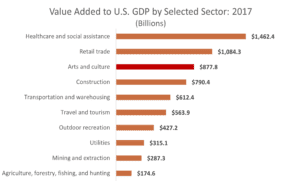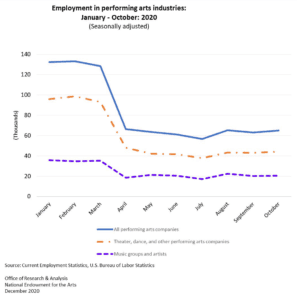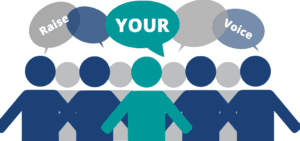Dear Colleagues,
If you ask me, the undisputed winner in our recent presidential inauguration was, yes, you guessed it, Arts and Culture!

The abundance of creativity, placed front and center during the inauguration and throughout the pandemic, demonstrates the indispensable value of arts and culture to soothe the soul and contribute to the psyche and economic recovery of our country. From the musicians who created an exciting and patriotic atmosphere, to the temporary public art installations honoring the lives lost to COVID-19; from the star-studded concert calling on all Americans to rise together, to the incredibly moving words of the young poet Amanda Gorman, the message of unity — conveyed through the arts — rang loud and clear.
Considering the pivotal role of creative industries in uplifting our country with hope, harmony, and healing, the time is now for those of us whose lives are enriched by arts and culture, to show support and advocate for the future of our sector and workforce.
According to a recent report produced by the National Endowment for the Arts, the Federal Emergency Management Agency (FEMA), and Argonne National Laboratory this $877.8 billion industry contributes “4.5% of U.S. gross domestic product (GDP), an amount larger than the share contributed by industries as diverse as construction, agriculture, and transportation.” In fact, “the value the arts add to the U.S. economy is five times larger than that added by agriculture, and $265 billion larger than that of transportation and warehousing.” And yet, ongoing research conducted by Americans for the Arts on the impact of the pandemic in the creative sector shows financial losses sustained by organizations across the nation are an estimated $15.03 billion as of January 25, 2021. “99% of producing and presenting organizations cancelled events” resulting in “a loss of $486 million for admissions and $15.4 billion in audience spending at local businesses” such as hotels, restaurants, parking, and many others. This research also shows a loss of 888,000 jobs, $5.2 billion in government revenue, and creative workers earning, “on average, less than half of what they anticipated” as 63% of them were unemployed by the end of 2020.


A study from the Brookings Institute warns that “any lasting damage to the creative sector will drastically undercut our culture, well-being, and quality of life” because it is “one of three key sectors that drive regional economies.” While the emergency funding previously distributed is highly appreciated, it is only a drop in the bucket and not enough to help the arts and culture industry overcome the immense uphill battle we face.
Data collected from 103 Arts & Humanities COVID-19 Relief Fund applications, submitted by Montgomery County based organizations, reveal 10,193 cancelled events, resulting in 1,049,266 cancelled tickets and individual experiences. The data also reflects $45 million in aggregate negative financial impact from: $32.8 million in lost revenue, $9.3 million in lost contributions, $1.5 million in nonrefundable event expenses, and $1.8 million in new expenses across the sector, a 300% greater impact than organizations originally predicted. Additionally, individual artists and scholars reported $1.8 million in aggregate negative financial impact.

If there was ever a time the arts and humanities sector needs your support, that time is now. EVERYONE’s voice must be heard. From legislators and business leaders to arts and humanities practitioners, cultural administrators, and enthusiasts, let me say emphatically, your voice matters!
Here are some ways you can get involved and keep creativity alive:
- Endorse policy proposals providing pathways of recovery such as To Rebuild and Reimagine the United States Post-Pandemic, We Must Put Creative Workers to Work, a Creative Workforce federal effort to get creatives back to work.
- Bolster initiatives and movements advocating for federal assistance for unemployed and struggling creative workers like Be An #ArtsHero.
- Contact your state and federal representatives to express your support for national and local creative economy recovery strategies. Write a letter, send an email, make a phone call, tag them on social media, etc.
- Register to attend Maryland Arts Day, the largest annual arts advocacy event for arts professionals in Maryland and ask your representatives to:
- Support funding Maryland State Arts Council (MSAC) at the mandated level of $27.3M
- Reject Governor Hogan’s proposed MSAC cut of $2.9 million
- Reject Governor Hogan’s proposed funding formula change for MSAC
- Support SB323/HB310, The Arts Capital Grant Program and
- Support SB256, Expanding Artistic Definitions for Arts and Entertainment Districts
When you do so, I encourage you to share your personal story with us. Record a video or post an image telling legislators how arts and culture positively impact your life and bring vitality to your community. As you think of your business’ recovery, discover ways you can incorporate creatives in the work you do. Can integrating creative workers enhance your workplace? Find out! And please, above all, continue patronizing arts and humanities organizations and supporting the work of individual artists and scholars.
We at the Arts and Humanities Council of Montgomery County believe there can be no national recovery without the creative economy. I’m hoping we can count on you to stand with us!
Onward,
Suzan
